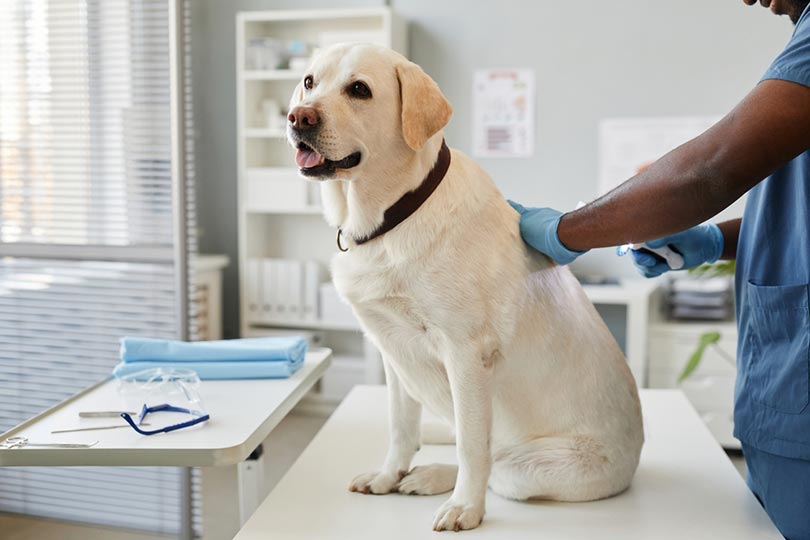Can a Dog Take Metronidazole Without Food? (Vet Answer)
By Dr. Kim Podlecki, DVM (Vet)
Updated on

Metronidazole is a medication frequently prescribed by veterinarians. Most commonly, it is used to help resolve diarrhea in dogs. Unfortunately, some dogs won’t eat when they are sick and not feeling well. Therefore, you may wonder if it’s still safe to give your dog metronidazole without food. The answer is yes! You can absolutely still give metronidazole to your dog without food.
What Is Metronidazole?
Metronidazole is a commonly prescribed antibiotic in veterinary medicine. It’s otherwise known as Flagyl. Metronidazole is only effective in killing anaerobic bacteria (bacteria that can only grow without oxygen), and some protozoa (single-celled organisms). Metronidazole works by gaining access to certain bacteria or protozoa, killing them from the inside out.
In veterinary medicine, metronidazole is most commonly used to treat diarrhea. More specifically, cases of diarrhea caused by giardia. Giardia is a protozoa that acts similar to a parasite. It is found commonly in water that dogs drink and play in before ingesting it. Giardia can also infect people.
What Else Is Metronidazole Used For?

Metronidazole is an antibiotic; therefore, it is only affective against bacteria and protozoa infections. More specifically, metronidazole is only affective against anaerobic bacteria, or bacteria that can grow without the use of oxygen.
Metronidazole is not affective against viruses, aerobic bacteria, fungal infections, or cancer.
How Is Metronidazole Administered?
Metronidazole can be taken orally or given intravenously (into the vein with an IV) while your dog is in the hospital. In veterinary medicine, it is commonly sent home as an oral medication for your dog to receive. Depending on the size of your dog, your veterinarian may prescribe it in tablets, capsules, or even liquid.
It’s important to follow your veterinarian’s dosing instructions carefully. If too little antibiotic is given, your dog’s infection won’t be appropriately treated. Conversely, if too much metronidazole is given, side effects (discussed below) can occur.
Veterinarians will usually recommend giving any type of tablet or capsule in a small piece of food. This is because a dog’s sense of smell is 10,000-100,000 times stronger than that of a human’s. Therefore, your dog may be able to sniff out the “medicine smell” of the metronidazole, even if you can’t. Wrapping the medication in some cheese, peanut butter, or lunch meat helps to hide that smell. Not to mention, your dog will be so happy they are getting a human treat that they likely will eat it quickly before the tablet dissolves on their tongue, or causes any bitter taste in their mouth.
My Dog Isn’t Eating. How Can I Give Metronidazole to Them?

Other medications, especially antibiotics, can commonly cause vomiting when given without food. But metronidazole does not typically cause vomiting when given on an empty stomach. Therefore, it’s generally safe for you to give the medication to your dog, even if they aren’t eating.
If your dog refuses to eat the snack-wrapped pill, simply open your dog’s mouth and “pill” them. It’s still recommended to keep the pill or capsule wrapped in the food, so that it doesn’t start to dissolve and/or become stuck while your dog swallows it. Keeping the medication wrapped will also stress your dog out less because they may think you are just giving them a snack. Unsure how to pill your dog? Here’s a quick tutorial on how to do it safely.
Side Effects
While it’s very rare with metronidazole, all antibiotics have the possibility to cause some nausea and upset stomach. Metronidazole can also cause tremors, seizures, and abnormal neurologic side effects when given at very high doses. If you notice that your dog is having tremors, difficulty walking, seizures, or acting abnormal after administration, stop giving the medication immediately. Call your regular veterinarian or the ASPCA poison control to find out if your dog may need a different dose of metronidazole, or a different medication altogether.
Final Thoughts
Metronidazole, an antibiotic commonly used in veterinary medicine for diarrhea, is safe to give your dog on an empty stomach. Veterinarians will often recommend you wrap the pill in a small amount of food to hide the smell and taste from your dog. However, if your dog will not take the snack, most veterinarians will recommend pilling your dog to make sure they receive the medication. If your dog continues to have diarrhea, anorexia, or is otherwise not improving despite you giving the metronidazole as prescribed, as always, contact your veterinarian.
Featured Image Credit: fukume, Shutterstock












